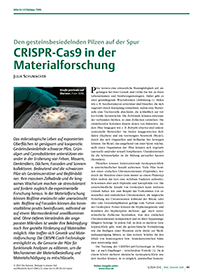CRISPR-Cas9 in material research
DOI:
https://doi.org/10.11576/biuz-7595Keywords:
Knufia petricola, schwarze Pilze, Biofilme, Pigmente, Genomeditierung, multiplexing, Resistenzkassette, TransformantenAbstract
Rock-inhabiting black fungi are adapted to the harsh life on rocks in deserts and release minerals from the rocks. The same adaptations enable these fungi to colonize man-made surfaces such as monuments, building facades and solar systems. Black fungi are often associated with phototrophic microorganisms. The slow growth and the melanized cell walls, which protect the fungi from extreme environmental influences, render molecular biological and genetic engineering methods difficult, which is why little is known about the biology of these fungi. Knufia petricola was selected to understand the processes of material colonization and damage with the help of adapted methods such as CRISPR-Cas9-mediated genome editing.

Downloads
Published
How to Cite
Issue
Section
License
Copyright (c) 2024 Julia Schumacher

This work is licensed under a Creative Commons Attribution-ShareAlike 4.0 International License.

